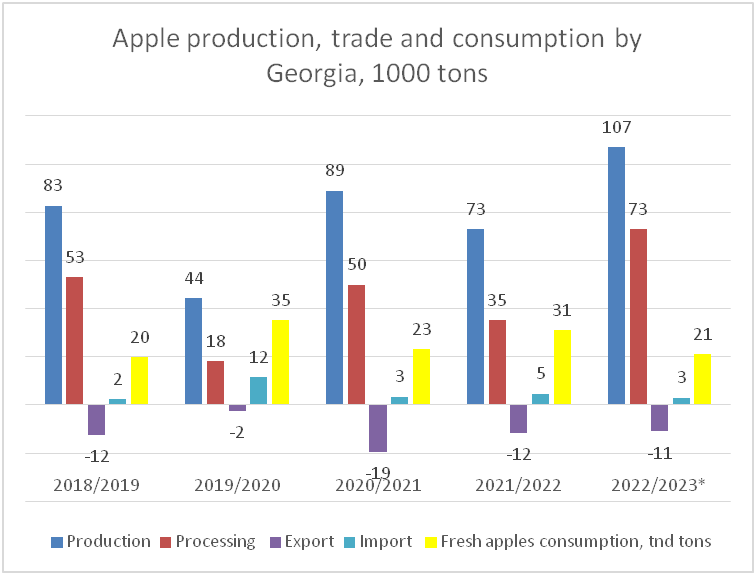The 2023 apple harvest in Georgia is expected to be the same yield compared to the 2022 season – about 100 tnd tons, but of lower quality due to the spread of the climate-induced apple scab disease. Like the last year, May and June 2023 appeared to be cold and rainy, which might negatively impact the quality of apples in the 2023 season, EastFruit notes.
Farmers were working to minimize the adverse effects by intensively spraying their orchards – about 30-40% more than the last season, negatively impacting the cost structure. Each spraying is at least 100 USD per ha, and this season farmers had to spray more than 14 times as the interval between spraying decreased almost twice. Labor costs have also risen, and farmers noted the labor shortage. This season, the daily wage for non-qualified workers ranges from 50-70 GEL ($20-25), compared to an average of 30-40 GEL ($10-15) in the previous season.
Commercial orchards with protective net coverage have been less affected by heavy rains and confirm that investment in the protection was the right decision. Some owners of intensive orchards also consider that this year due to intensive spraying, the quality of their apples will stay the same. Moreover, a large portion of the harvest will exceed +75 caliber thanks to high precipitation.
The biennial bearing phenomenon might also affect this year’s harvest, although its impact decreases gradually. This season at least commercial apple farmers expect little deviation in yields due to alternative bearings, as many use the thinning method (mechanically and chemically) to eliminate the alternate bearing. According to the industry expert Dr. Zviad Bobokashvili, a strong spring frost occurs every ten years, causing significant damage to the apple harvest and restarting the biennial bearing effect. The last such frost in Georgia was in 2017, and its effects gradually diminished in subsequent years until another occurrence.

Data source: GeoStat (production, except 2022/2023 – assessment), Ministry of Finance of Georgia (Trade)
*Seasons taken from August to July 22-23 do not include July data
How many hectares of apple orchards do Georgia has?
Although there is no official data on the total area of apple orchards in Georgia, it is estimated that old orchards (extensive, old varieties) still make up a considerable portion (>50%) of the overall apple cultivation area.
According to the Georstat 2014 census, the Shida Kartli region, a leader of apple production in Georgia and contributes 74% of apple production, has 9-10 tnd hectares of apple orchards, and according to Dr. Zviad Bobokashvili, head of the fruit crops department of the Scientific Research Center of Agriculture of Georgia, only about 40-50% of them are intensive, including those financed by the Rural Development Agency of Georgia’s “Plant the Future” program.

Data source: Rural Development Agency of Georgia
The most planted varieties
Farmers in Georgia have identified Golden Delicious as the most widely planted apple variety, comprising around 40-50% of orchard cultivation. This is followed by Granny Smith, Gala, and red varieties such as Start or Red Delicious. Other types like Fuji, Jonagold, and Pinola are grown in smaller quantities. Consumer preferences influence the selection of these varieties in local and global markets. According to farmers, Golden Delicious remains the most sought-after variety in domestic and traditional international markets. Additionally, three older varieties, Kekhura, Winter Banana, and Reinette de Champagne (Brodski), were popular among farmers and consumers more than 15 years ago and are harvested only in old orchards today.
Read also: Prognosfruit 2023/24 Apple Forecast – What to expect from the new season?
Prices
Farmers in Georgia faced challenges in making price forecasts for this year’s apple season. Commercial producers sold modern apple varieties in the local market the previous year for an average price of 0.8 to 1.5 GEL ($0.3-0.5). However, the price for the current season is uncertain and dependent on various factors. The quality issues caused by diseases and lower yield years may favor higher prices. Still, the outcome will depend on the activity of importers and the prices in other apple-producing countries.
The use of the site materials is free if there is a direct and open for search engines hyperlink to a specific publication of the East-Fruit.com website.




